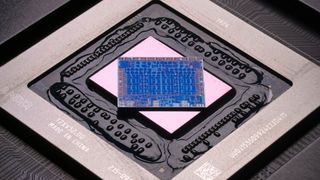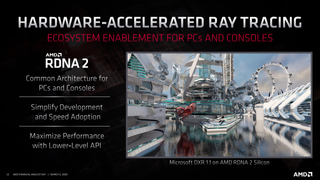AMD targets 1440p ray tracing but DLSS alternative not ready until well into 2021
AMD's Rick Bergman says Xbox Series X and Sony PS5 will give AMD a ray tracing advantage on PC.

AMD is targeting the 1440p resolution for its ray-tracing technology in the new Radeon RX 6000 line of GPUs. So says AMD senior suit Rick Bergman in an interview with investor outlet The Street. Bergman also implied that AMD’s answer to Nvidia’s image-quality enhancing technology, DLSS, isn’t coming any time soon.

Best CPU for gaming: the top chips from Intel and AMD
Best graphics card: your perfect pixel-pusher awaits
Best SSD for gaming: get into the game ahead of the rest
AMD kept conspicuously mum regarding the ray-tracing performance of the RX 6000 series and RDNA 2 architecture when it announced the new graphics cards at the end of October. For some observers, that implied AMD had something to hide. After all, if AMD's ray-tracing performance was spectacular, surely it would be clearly showcased. However, with reviews of the new boards imminent, Bergman is willing to hint at what we can expect from AMD’s new architecture.
“Our goal was at 1440p to have a great ray tracing experience. That was kind of the performance level that we targeted. Now it depends on particular games and everybody's systems and so on, but I think you'll find that we have very good ray-tracing performance overall.”
He also emphasises that the console connection could be critical for ray-tracing performance. AMD’s RDNA 2 technology, of course, powers the graphics in both the new Sony PS5 and Microsoft Xbox Series X. Bergman implied this means RDNA 2 will set the standard that games developers work to when it comes to ray tracing.
“So as you know, the RX 6000 line uses the RDNA 2 underlying architecture, and that's what Sony and Microsoft also use. Probably more than any other feature, that's where we're going to get leverage from being the silicon provider for the game consoles as well as PC.
Obviously, they influence the ISVs tremendously in terms of platform direction, and in terms of the best way to implement ray-tracing, the right balance of which features you implement for the right performance levels, and so on,” he says.

Put another way, this could mean that many games will be developed to suit the ray-tracing capabilities of RDNA 2. Nvidia’s RTX technology might be faster at ray tracing, but that won’t necessarily be an advantage if games are coded to run fast enough on RDNA 2.
The biggest gaming news, reviews and hardware deals
Keep up to date with the most important stories and the best deals, as picked by the PC Gamer team.
Of course, if Nvidia does have a ray-tracing advantage, it could come in part from its DLSS technology, which allows games to run at lower and less demanding resolutions, but be scaled up to mimic the visual fidelity of higher resolutions. Bergman confirmed that AMD’s answer to DLSS, known as FidelityFX Super Resolution, is coming. But it seems we may have to wait some time.
“We are committed to getting that feature implemented, and we're working with ISVs at this point. I’ll just say AMD’s approach on these types of technologies is to make sure we have broad platform support, and not require proprietary solutions [to be supported by] the ISVs. And that's the approach that we're taking. So as we go through next year, you'll get a lot more details on it,” Bergman says.
More details ‘through’ next year doesn’t sound like it will be available terribly soon. Exactly how important that will prove in the broader battle with Nvidia, well, we’ll have to wait and see.

Jeremy has been writing about technology and PCs since the 90nm Netburst era (Google it!) and enjoys nothing more than a serious dissertation on the finer points of monitor input lag and overshoot followed by a forensic examination of advanced lithography. Or maybe he just likes machines that go “ping!” He also has a thing for tennis and cars.
Most Popular





